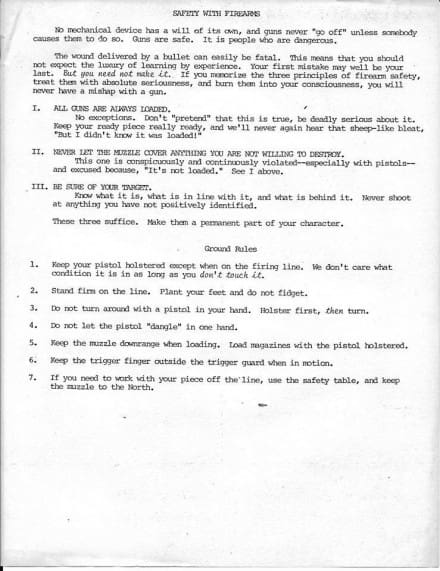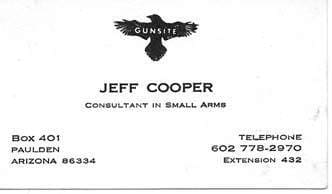Later, these rules were adapted slightly:
RULE I: ALL GUNS ARE ALWAYS LOADED
RULE II: NEVER LET THE MUZZLE COVER ANYTHING YOU ARE NOT WILLING TO DESTROY
RULE III: KEEP YOUR FINGER OFF THE TRIGGER UNTIL YOUR SIGHTS ARE ON THE TARGET
RULE IV: BE SURE OF YOUR TARGET
Tags: Gunsite, Jeff Cooper




1 How do gunsmiths fit shotguns and work on any kind of firearm and how do we inspect our barrels for condition if all guns are always loaded?
2 There is NO safe direction to point a weapon whose range is measured in miles, except at the backstop when on the firing point. So we need some other means of avoiding a fatal negligent discharge.
3 This is the ONLY vital rule.
4 Can’t argue with that.
Argue your points with someone else. http://www.thetruthaboutguns.com/2014/02/robert-farago/self-defense-tip-teach-one-rule-rule/
I think it really depends on your audience. I know my wife was trying out someone’s shotgun (I forget the model but it has a safety button on the trigger guard forward of the trigger). She’s right-handed and the owner is left-handed and had the safety button’s action reversed. Because she followed rule #2, when her gloved hand happened on the trigger while she was trying to put the weapon on safety she managed to avoid doing any damage except to a small patch of grass in front of her.
1) Gunsmiths work, generally, with firearms broken into parts. Firearms are loaded, parts are not.
2) While technically true, and forward thinking, you might be a little out in the weeds on this one. If you’re working in heavy calibers make sure to do it near a burm or just don’t nitpick so much?
3) Can’t argue with keeping your finger off the activation button when you don’t want the machine to activate.
4) Good
I assume #1 to mean
A) Keep your ready firearms READY and always loaded
B) Assume all other firearms to be loaded until proven otherwise.
Don’t over think these.
While you do bring up a good point, if you keep your weapon safe within 100 yards of your position, then by proxy you would be keeping things safe out to your maximum range.
It all comes down to being aware of your surroundings and acknowledging the fact that the firearm itself is only dangerous when you involve a human element.
Just be smart people.
You aren’t very popular are you?
Wow, Glenn….when you look at lot of trees growing together, I bet you don’t even bother to notice the forest, do you?
1: You are missing the reason this is a rule. It is meant to keep people from doing dumb stuff with a firearm simply because they think it is not loaded. This rule is meant to keep people from ND’ing because they thought the gun was “safe”. Instead of having two different ways to handle guns, loaded and unloaded you get one. It simplifies everything and helps combat bad habit formation.
2: You are over thinking this. A safe direction is a direcion where a round won’t hit anything it should not should one leave the barrel. This changes based upon situation. On a square range it is the back stop. If the ground does not present a ricochet hazzard it can be down. At a clearing barrel, it is the barrel. If you have miles and miles of miles to work with it could be thiose miles and miles of miles. What a safe direction is not is at people, places, or things you don’t want holes in (see #4).
3: This is not the only vital rule. It may be a last line of defence but it is not the only rule that is needed. To say otherwise is asking for bad things to happen. Bad habits happen and so do ND’s. If your only rule is don’t accidentally shoot (the whole point of trigger dicipline), what happend when you do and you have ignored the other rules? You put a hole into something that should not have one.
4: No one can argue with this one. If it does not need holes in it, don’t point a machine tha makes holes at it. If stuff behind it does not need holes in it, don’t point a machine tha makes holes at it.
Keep these rules on hand when training the Boy Scouts